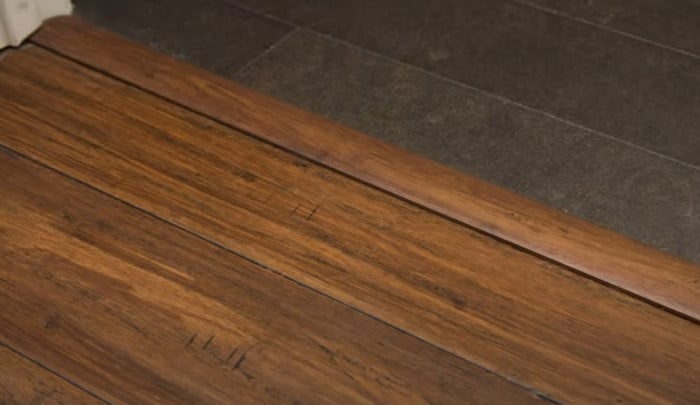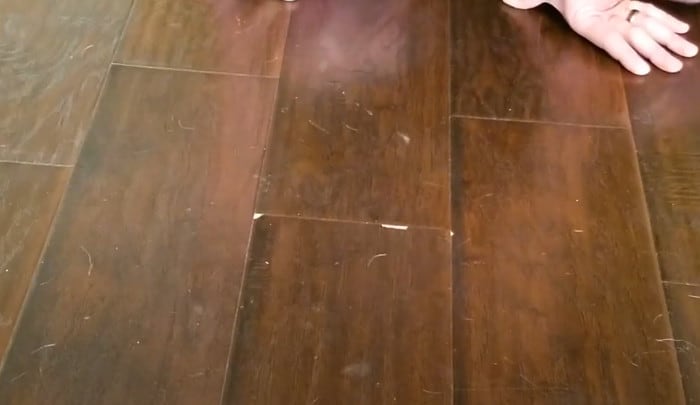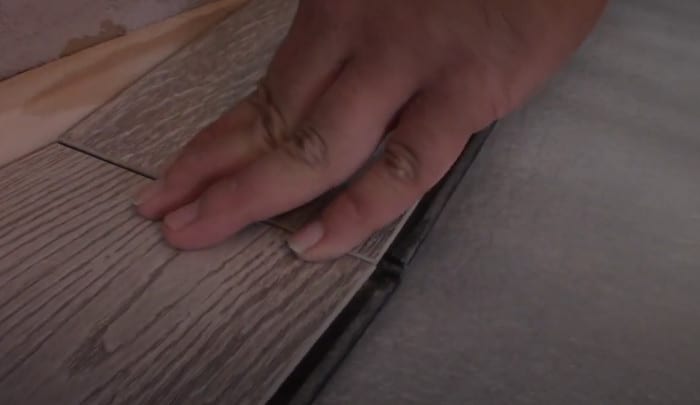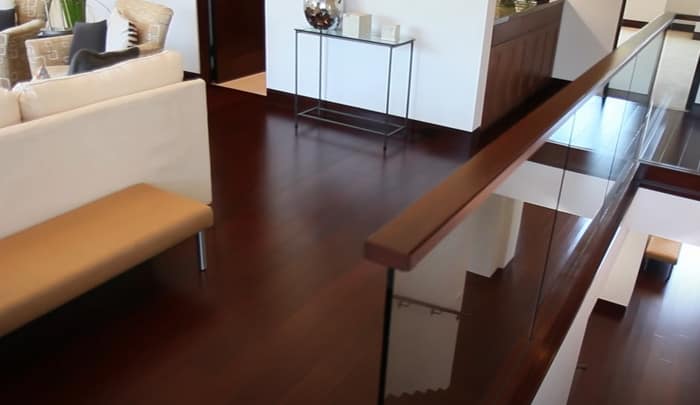If you’re looking to upgrade the floors in your home, you might be considering laminate flooring as an option. But with all types of flooring, there are certain things you need to know – like if laminate flooring can expand. That’s why you’re here today – to learn the ins and outs of laminate flooring, and whether or not it can expand.
We’ve done the research and have the answer you’ve been seeking – so without further ado, let’s take a look at what you need to know about laminate flooring and it’s propensity to expand. We’ll also explore the importance of expansion and why you need to consider it when installing and maintaining your laminate floor. Let’s get right to it!
Laminate flooring, which is made of hardwood-style layers, can be impacted by changes in temperature and humidity. The expansion or contraction of laminate flooring will depend on the type of planks and the installation method used.
“Yes, it’s absolutely true that laminate flooring expands and contracts. This is primarily due to fluctuations in temperature and changes in humidity levels. Over my career, I’ve found that it’s essential to leave an adequate gap at the wall perimeters during installation to accommodate this natural movement, or else you may encounter problems down the line.”
Gerhard Townsend, Flooring Engineer
Does Laminate Flooring Expand?
The answer to this question depends on a variety of factors such as where the flooring is being installed, the climate of the environment, and how it’s maintained. Some people will argue that yes, laminate flooring can expand in certain scenarios. It may be caused by exposure to moisture in its environment which can cause expansion due to swelling. It is also contingent on what type of installation was done with the flooring as some flooring techniques may be safer for avoiding expansion than others. On the other hand, there are those who claim that no, expansion isn’t possible for laminate flooring because it is not made from real wood or vinyl. Laminate floors are actually made from layers of paper-based material that are pressed together and contain an extremely hard coating. Thus, when exposed to moisture, well-made laminate floors won’t absorb moisture and therefore won’t swell and expand as a result.
Regardless of which side one falls onto in this debate, establishing and maintaining a safe environment for your laminate flooring is important to preserve it. Fortunately, both sides of the argument agree that careful measures must be taken to prevent expansion and damage due to moisture accumulation in the air or on the surface of the floor. Next in our article let’s discuss what those measures might be and how they impact laminate flooring – The Effects of Moisture on Laminate Flooring.

- Laminate flooring is subject to a certain degree of dimensional change due to temperature and humidity.
- The National Wood Flooring Association recommends that there should be a minimum of a ¼ inch gap between the edges of laminate floor boards and any walls or permanent obstructions.
- Studies have found that laminate flooring can expand up to 0.08 inches per linear foot for every 10 degree increase in temperature.
Must-Know Points
This text provides a debate on whether or not laminate flooring can expand due to moisture. Although there is no conclusive consensus, it is important to establish and maintain a safe environment for your laminate flooring in order to preserve it. Moisture accumulation should be prevented in order to reduce the risk of expansion and other damage.
The Effects of Moisture on Laminate Flooring
When discussing laminate flooring, it’s important to consider how moisture can affect its performance. While laminate flooring is traditionally thought of as a water-resistant product, it is still susceptible to warping and swelling from excessive moisture levels. This is especially true when the flooring is exposed to high humidity or standing water for extended periods of time.
Excessive moisture can cause the materials that make up the laminate flooring surface to swell and become distorted, leading to visible buckling, bubbling, warping or cupping in individual pieces of the flooring system. In addition, water penetration directly into the core layers beneath the wear layer can lead to warping and expansion of individual plank boards.
Furthermore, high humidity levels can also cause adhesives used in locking systems between planks to release their bond, resulting in further shifting and expansion of individual plank boards. On the other hand some types of laminate flooring are designed with a waterproof or water resistant core which works to protect against water penetration. This type of flooring has been engineered so that the wear layer fuses with the core layer and will not expand when exposed to prolonged exposure from moisture.
It is important to remember that even waterproof laminate flooring is not completely impervious to damage from excessive moisture. If present for long enough, standing water can eventually get through tiny spaces between planks and track along joints where it will accumulate at a lower level of the structure. Ideally, all areas should be sealed properly with a commercial grade sealant before installation in order to ensure optimal moisture resistance for your new laminate flooring system.
Therefore it is evident that while many laminate floors are designed with built-in protection against moisture intrusion, they may still suffer if exposed to excessive humidity or water for long periods of time. As this section continues into discussing “How Moisture Could Cause Expansion” readers must be sure they take preventive measures such as proper sealing prior to installation; this will prevent any possible damage should excess moisture come into contact with their laminate flooring system.
How Moisture Could Cause Expansion
When it comes to laminate flooring and expansion, one of the most important factors to consider is moisture. Moisture in the environment where the laminate floor is installed can cause contraction and expansion of the material due to climate conditions. Generally speaking, too much moisture could cause an increase in expansion, while not enough moisture could cause contraction.
The debate over whether excessive Moisture will expand laminate flooring arises because some experts believe that if too much moisture is present in a room, the laminate can absorb this and swell up. This swelling up of the laminate can then lead ultimately to negative consequences such as buckling and warping. On the other side of the spectrum, many professionals disagree with this argument and deem laminate virtually impervious to movement from excess moisture and instead attribute any warping or buckling caused by moisture to improper installation methods or sub-par installation quality.
Other experts claim that when laminate flooring was first invented, it had been designed with a higher tolerance for expansion when confronted with excess moisture. This meant that manufacturers included melamine resins within the construction of the material in order, using this technology for added protection against expansion which could be caused by high levels of atmospheric humidity.
Overall, it is very important to take into account environmental conditions before deciding to install your laminate flooring. Too much or not enough moisture can have a significant impact on how your laminate expands and contracts over time, so it is essential that you give careful consideration to climate conditions prior to installing your laminate flooring and make sure that it is installed correctly. This brings us onto our next section about temperature and laminate flooring – how does temperature affect Laminate Flooring?

Temperature and Laminate Flooring
Temperature plays a major role in the expansion and contraction of laminate flooring. Just like wood and other materials, when exposed to extreme temperatures, laminate flooring is adversely affected. In general, extreme temperature or dramatic changes in temperature can cause laminate floors to expand or contract over time, leading to increased levels of wear and tear on the surface. This can even lead to issues with fastening systems and improper spacing between parts, thus causing the entire floor to become unstable.
While it is true that extreme heat or cold can cause laminate floors to experience some form of expansion or contraction, there are also positive impacts on flooring from small changes in temperature. Small increases and decreases in temperature can actually help increase the stability of laminate floors by redistributing their weight more evenly across the surface. This helps the planks align more properly and reduces the potential for warping in the future. Ultimately, this ensures that your floor will last longer and look better longer.
At the end of the day, it is important to remember that while temperature should not be ignored when dealing with laminate flooring, it is important to keep any extremes in perspective. With proper planning, installation and maintenance, you should generally never run into any serious issues around expansion or contraction due to temperature changes.
In conclusion, temperature is an important factor for consideration when it comes to installing laminate flooring but with proper preparation and regular maintenance, a great looking and long lasting laminate floor can be achieved. The next section takes a closer look at how moderate temperature changes may affect your flooring system by discussing “Expansion and Contraction from Temperature Changes” in more detail.
Expansion and Contraction from Temperature Changes
When it comes to laminate flooring and temperature changes, expansion and contraction should always be taken into consideration. Due to the synthetic nature of laminate, it can be affected by temperatures that are either too hot or too cold. As the temperature rises, many types of laminate flooring can expand up to 1/4-inch for every 10-feet. On the other hand, contraction can occur as the temperature drops.
Some industry professionals debate that laminate is more likely to expand than contract due to overly cold temperatures or extreme humidity levels. It is believed that large amounts of moisture can contribute to contraction when exposed to cold air as the moisture creates condensation and small amounts of water can sometimes become trapped in between the planks of laminate flooring causing them to retract during colder months. Even if this were plausible, many argue that these extreme changes in temperature rarely occur in a home’s interior and therefore cannot cause significant damage during normal weather conditions.
Regardless of what one believes regarding the effects of extreme temperatures on laminate flooring, it is important to note that expansion and contraction may occur depending on the conditions within a space. As such, proper installation techniques should always be employed when installing new laminate floors to create allowance for shifts from temperature changes throughout the year. This will be discussed further in the following section about “Expansion Gaps for Laminate Flooring”.
Expansion Gaps for Laminate Flooring
When installing laminate flooring, expansion gaps are a critical consideration, as they provide space for the material to expand and contract with changes in temperature. While it is generally recommended to leave an expansion gap of at least 1/8 of an inch (or more depending on the space) between the laminate and walls, baseboard, doorways, and other obstructions, there are those who argue that this is unnecessary. The debate concerning expansion gaps may revolve around two main points: Performing the installation without an expansion gap could cause damage or inconvenience to one or more of these disturbances; however, leaving too much space could create an unsightly gap which can disrupt the overall look and aesthetic of the room.
Ultimately, professionals recommend that homeowners err on the side of caution when dealing with expansion gaps in laminate flooring. In most cases, a 1/8-inch gap minimum should suffice; however, depending on the size of your space and how large and frequent temperature changes are known to be in your area, you may opt to create a larger gap as a preventative measure against potential problems down the road.
With such a variety of factors to consider when it comes to laminate flooring installation, understanding the differences between floating vs. glue laminate installation can be helpful for navigating these complex decisions. Moving forward to the next section, we will discuss the advantages and disadvantages of both floating and glue laminate installations.

Floating vs. Glue Laminate Installation
When it comes to laminate flooring installation, there are two primary methods: floating and glued-down installation. As the name implies, in a floating installation, laminate is not affixed directly to the subfloor. Rather, individual planks used in this type of installation are connected together by means of an interlocking system that allows them to move a little bit independently. This gives the floor more flexibility when there is moisture or heat causing it to expand or contract.
On the other hand, glue-down installation involves attaching each plank to the subfloor by means of adhesive spread over its bottom surface. While not as popular as floating installations, glue-down’s main advantage is increased stability since it eliminates any potential for floor movement that is present with floating installations. Additionally, it increases sound insulation and can make for easier future changes if needed.
Given these distinct advantages and disadvantages offered by both types of laminate installation, which one is ultimately ideal will depend on your own needs. If you want minimal maintenance, fast installation and go for aesthetic options that may offer texture or hand scraped looks and don’t mind possible shifts then a floating option may be best. On the contrary if needing an ultra stable floor due to large pets or high risk areas like laundry rooms then going with a glued down option makes sense.
The next section will explore another important aspect of laminate flooring: the benefits of locking laminate planks.
The Benefits of Locking Laminate Planks
Locking laminate planks provide a few unique benefits when compared to standard laminate flooring. Primarily, locking planks are much easier to install than traditional formats since the tongue and grooves do not need to be precisely aligned and manually hammered together. Locking planks literally snap together like a puzzle, no special tools or skills required.
Particularly in tight spaces such as bathrooms, laundries and around the edges of kitchen islands or peninsula counters, installing locking laminate floors can save considerable time and effort. Additionally, installation can be done without needing any professional help; if DIY-ers decide to go with a traditional laminate floor they would likely require some assistance due to the complex assembly._
The argument against this type of flooring is that standard floating plank flooring systems have come a long way in terms of ease of install and click systems can be very secure as long as they’re properly fitted together. Specifically for DIY-ers who want a more complicated finish with their project, traditional formats might be better because it’s extremely difficult to replicate a hand-sanded finish on locking planks – there’s just not enough room within the tongue and groove joints for anything other than grinding out a beveled edge.
In conclusion, whether a homeowner chooses standard or locking laminate planks ultimately comes down to how experienced they are with DIY projects and what kind of finish look they want for their space. Regardless of format however, all laminate floors should still always be firmly attached (via stapler or adhesive) to the subfloor prior to installation. With this in mind, let’s move onto our conclusion…

Conclusion
When it comes to laminate flooring, the expansion and contraction is a reality that all homeowners must take into account. Due to its construction, laminate expands and contracts with temperature fluctuations. Although, since manufacturers are more aware of this issue today than ever before, they have taken measures to reduce the impact of expansion and contraction on their products.
One way they do this is by providing underlayment options with their products which can help reduce the amount of potential expansion. Also, modern laminates typically made with HDF (high-density fiberboard) will be less susceptible to expansion and contraction due to the higher quality material used.
Overall, expanding and contracting is something that all homeowners should consider when deciding if laminate flooring is the right choice for them. It’s important to remember that temperature and humidity levels in your home can cause laminate to expand and contract even more than other types of flooring, so be sure to take steps to mitigate any negative effects.
It’s also important to follow the manufacturer’s instructions when it comes to using proper subflooring materials, spacing between planks, installing in large rooms, etc. Taking these steps will help ensure your laminate floor looks great for years to come.
Frequently Asked Questions
What type of environmental conditions cause laminate flooring to expand?
Laminate flooring can expand due to changes in environmental temperature and humidity. When temperatures rise, the material can expand due to thermal expansion and when humidity increases, the material absorbs moisture which can cause it to swell. This phenomenon is known as humidity expansion and it is one of the most common causes of flooring expansion. To prevent this from happening, you should maintain a relative humidity level between 30-50% and keep temperatures steady at around 70 degrees Fahrenheit. Additionally, you should always allow for expansion margins of 3/8” between boards when installing laminate flooring.
How much does laminate flooring expand and contract?
Laminate flooring has a tendency to both expand and contract depending on the environmental conditions. Generally speaking, laminate flooring can expand up to 3/4 of an inch for every 40-50 feet. Similarly, it can contract up to 1/4 of an inch for the same amount of space. In areas with higher humidity, it may expand even more, while in dry climates laminate may contract more significantly. Additionally, material quality and the type of installation method can also affect how much the floor will expand and contract over time. Overall, homeowners should be aware that some expansion and contraction of their laminate flooring is normal over time and should prepare appropriately by leaving space between walls during installation.
How should laminate flooring be installed to prevent expansion issues?
Laminate flooring should be installed according to manufacturer instructions and with the use of a vapor barrier. Vapor barriers are designed to prevent the passage of moisture from underneath the laminate floor, which may cause expansion and damage to the flooring. Additionally, the subfloor should be clean, dry, flat and level prior to installation, as any unevenness could create a space for water expansion. Finally, always leave a 3/8” gap between walls, baseboards and transition strips to give room for the flooring to expand without buckling or warping. When properly installed, laminate floors can last anywhere from 15 – 20 years with minimal maintenance.
References
https://www.lowes.com/n/buying-guide/laminate-flooring-buying-guide





When I was replacing my floor, I opted for laminate. Having observed the floor over four seasons, I can confirm that it does expand and contract. However, proper installation can significantly minimize the impact of these changes.
Lazenby, you nailed it! Lack of proper installation often leads to issues with expansion and contraction. Having seen hundreds of floor installations, I find that plenty of problems arise not from the material itself but shoddy workmanship.
Your point, Mabel, strikes me as accurate. I’ve handled many floor installations over my career and I agree wholeheartedly that shoddy installation can cause problems with expansion and contraction. Even the best materials will perform poorly if incorrectly installed. All too often, people overlook the importance of hiring experienced professionals in favor of saving a few dollars, a mistake they come to regret down the line.
The expansion of laminate flooring element should indeed not be overlooked, I’ve experienced a few hiccups in one of my installations when I didn’t account for expansion gaps. Paid the price later with buckling and peaking.
I’ve seen my fair share of warped laminate caused by poor consideration of expansion gaps; it’s a costly mistake that can easily be avoided with careful planning.
I agree with you, Paxton – the importance of accounting for expansion can’t be understated. I once tried to fit my laminate right up to the wall without leaving any room for natural expansion due to heat. As a result, the flooring warped within weeks and I had to replace it all over again.